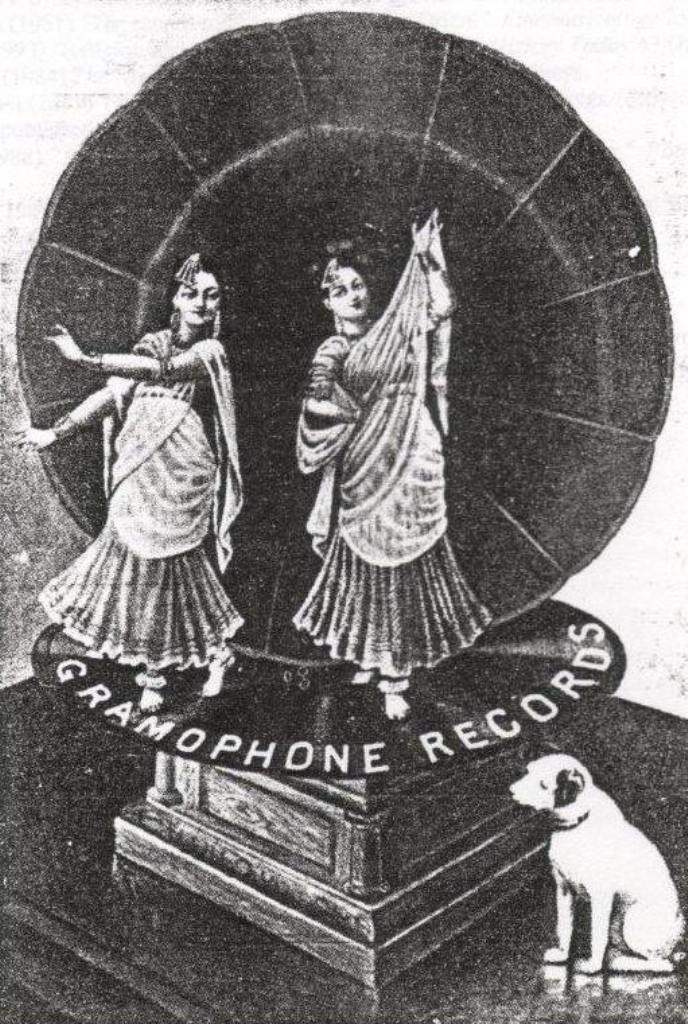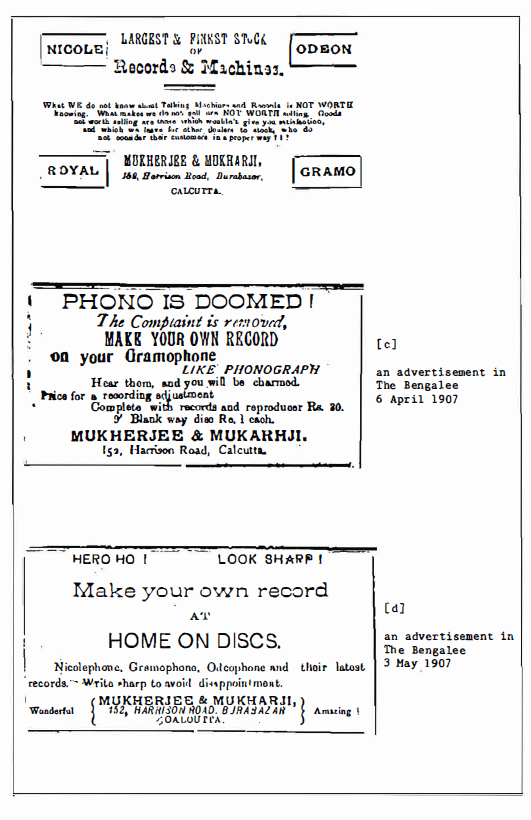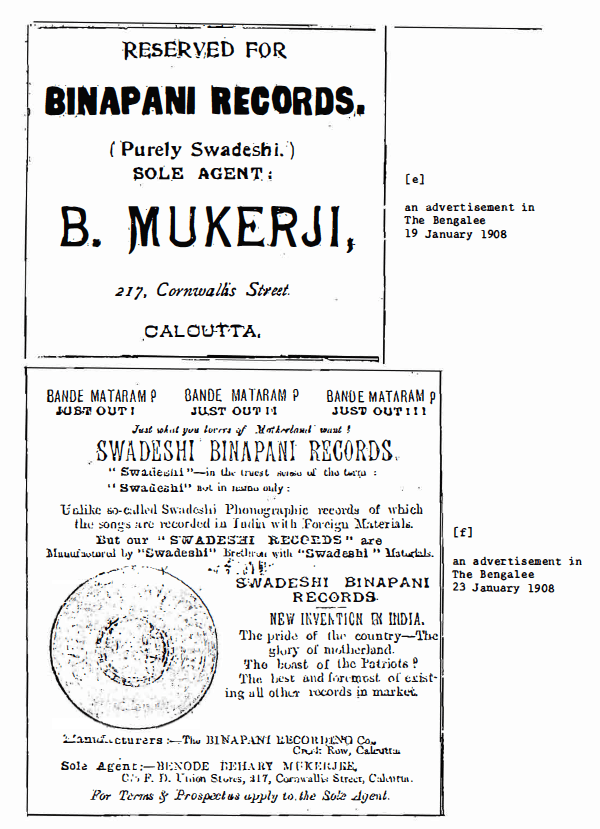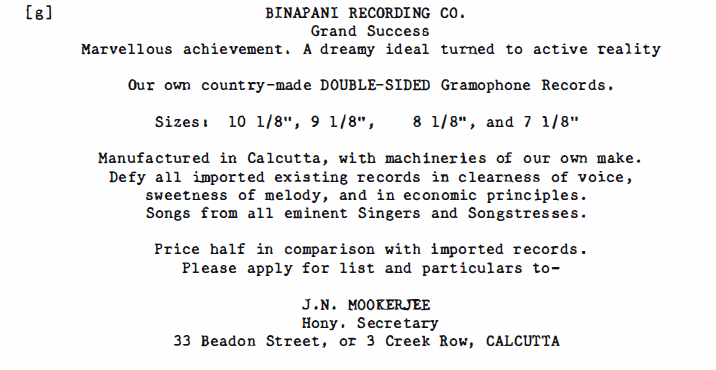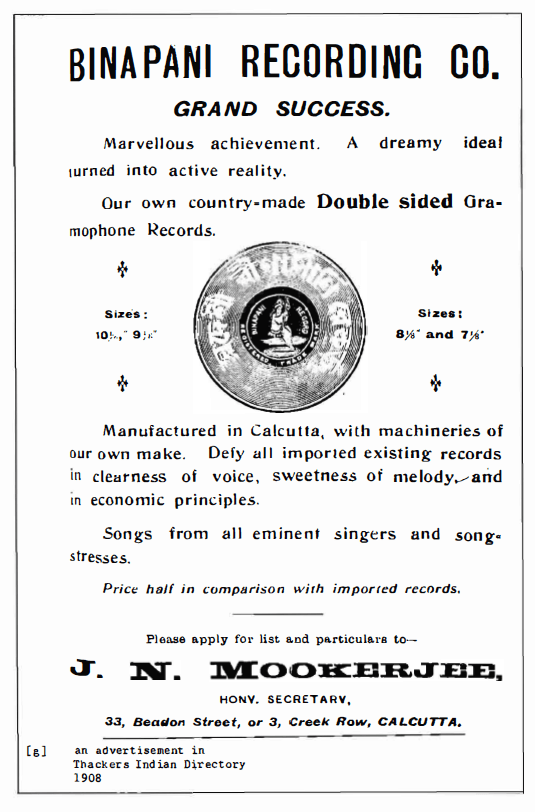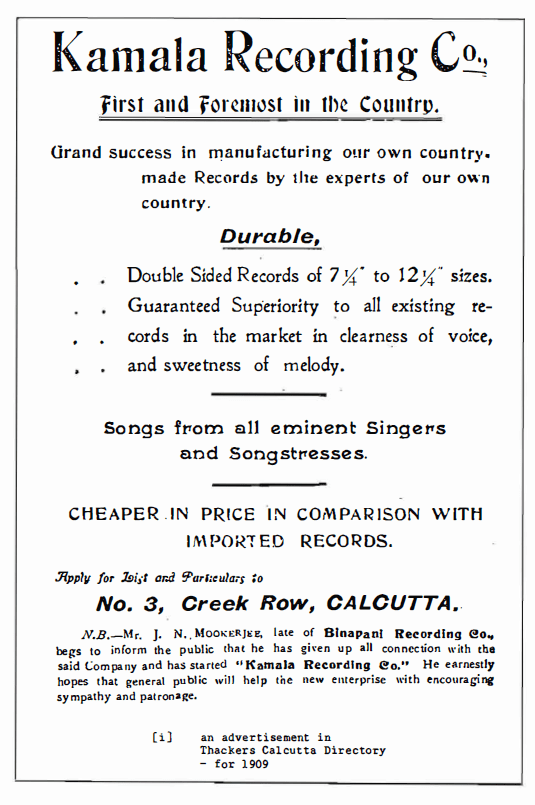THE FIRST INDIAN DISC RECORD MANUFACTURERS
By Michael Kinnear
A research inquiry concerning the
ROYAL RECORD, BINAPANI RECORD, KAMALA RECORD
This article attempts to piece together the history of the FIRST Indian disc record manufacturers from printed sources – and although much of what is known about the FIRST Indian disc record manufacturers contains a ‘fair amount of speculative information and data,the evidence presented herewith also reveals positive clues and proof in regard to the fact that The Gramophone Co,, Ltd., was certainly NOT the first disc record company to manufacture disc records in India, despite the popular belief in the theory that they were.
In the following article I am presenting information about the FIRST indigenous disc record manufacturers of India, and what makes this article interesting on the one hand also makes it most frustrating on the other, is the fact that over several decades of research and searching for copies of such disc records (in any condition) I have not found or been advised about one single example of the three makes in question,
That the very FIRST manufacturers of Indian disc records – as distinct from manufacturers of cylinder recordings – have not been documented to date has been basically due to the fact that NO pressings of the very first disc records manufactured in India have come to light or appear to have been preserved by any collector or deposited in any archive.
Neither have any listings or catalogues been located to verify the extent of the output and scope of these first Indian disc record manufacturers, and the only evidence that such indigenous Indian disc record makers ever existed is based solely on advertisements placed by the record companies in the newspapers of Calcutta during the existence of the record companies which lasts over little more than a couple of years between 1906 to 1909.
The names of the three record companies involved in the manufacture of Indian disc records are Mukherjee and Mukharji, Binapani Recording Co,, and Kamala Recording Co., (successor to the Binapani Recording Co.) all three record companies were based in Calcutta, and confined their business activities to that city, which at the time was the capital of India.
Before looking at what is known about these three record companies it will be well to look at the historical panorama which the developing sound recording industry in India was facing between 1906 and 1910.
Early Talking Machine Traders
At the turn of the century there were several merchants in both Bombay and Calcutta who had taken a direct interest in becoming directly involved in the sound recording industry of India. Amongst the musical instrument dealers and general merchants seeking to make a name for themselves by expanding their business interests in musical instrument manufacture or sales into the sound recording industry the names of Dwarkin and Son, 8 Dalhousie Square, Calcutta, J. Fleming & Co., (trading as the Universal Talking Machine Depot) 170 Dhurramtolla Street, Calcutta, and H. Bose, Perfumer, 60 Bow Bazar, Calcutta, were pioneers of this burgeoning trade in Calcutta, while Valabhdas Runchordas & Co., 15 Elphinstone Circle, Fort, Bombay, The James Manufacturing Coy, 103 Kalbadevi Road, Bombay, and T.S. Ramchunder and Bros, 26 Kalbadevi Road, Bombay, were the main retail merchants for ‘talking machines’ and sound recordings on the West coast of India.
During the course of the next couple of years almost all of these firms became more directly involved in the sound recording industry of India, and might have fashioned the industry in India to something of their own ideals were it not for the fact that the sound recording industry in India was controlled by businesses which had a patent interest or were based in Europe, and thereby virtually dictated how the ‘Indian’ sound recording industry would develop.
There has been a general assertion over the past several decades that The Gramophone Co., Ltd., were the first sound recording company to actually manufacture disc records in India, from their factory at 139 Beliaghatta Road, Sealdah., Calcutta.
In essence – The Gramophone & Typewriter, Ltd., were the most prominent and aggressive sound recording company operating in India to the extent that between 1903 and 1908, they had taken several thousand recordings and achieved the highest profile in the marketing of sound recordings in India – despite the fact that up until May 1908 all of their pressings of e territory that The Gramophone & Typewriter, Ltd., took recordings in for their ‘oriental’ catalogues in the Asian region included India, Burma, Ceylon, China, Dutch East Indies, Siam, Singapore and the Malay States, so in order to cater for the public demand for disc records it would have made good sense for the company to have a disc record manufacturing plant located somewhere in Asia, and India then being a part of the British Empire seemed the logical place to erect a disc record factory.
The Gramophone & Typewriter, Ltd., may have been spurred into the action of building their own disc record factory in India by two protagonists who were hopeful of erecting their own disc record and ‘talking machine’ factories in India. Shunker Dass & Co., Nila Gumbaz, Lahore, had been advertising in an English talking machine trade paper for some assistance in erecting a factory at Lahore, and a company in the name of The Oriental Sound Recording Company, was proposed to be formed – the personnel backing the venture had naively approached The Gramophone & Typewriter, Ltd., with the concept of building a factory at either Bombay or Calcutta and offered to assist The Gramophone & Typewriter, Ltd., with the manufacture of disc records from the ‘Oriental’ factory.
By 1908, The Gramophone Co., Ltd., had achieved supremacy in the marketing of disc records in India and virtually controlled the retail side of the industry in that most of the major retail outlets and merchants were ‘Gramophone’ agents – and it might be added – persuaded not to handle or carry any other makes of disc record. This dominance of the sound recording industry in India was probably more due to business acumen and abundant financial resources rather than any keen knowledge of the musical cultures of India – for which the company was dependent upon a number of local brokers – whose advice as to whom and where recordings should be taken was essential for the company’s success.
For the other sound recording companies (or their agents) active in India this meant seeking to compete in a market – not only for recording talents but also for retail outlets and dealerships which might be able to promote their repertoire of recordings — other than that of the ‘Gramophone’.
Amongst the sound recordings companies that had been active in India were Nicole Freres, Ltd., [NICOLE RECORD], through Nicole Freres (India) Ltd., Beka Record, G,m,b,H,, [BEKA GRAND RECORD], through The Talking Machine and Indian Record Co., International Talking Machine Co., m.b.H., [ODEON RECORD] through The Talking Machine Co,, of India., Lyropbone-werke made the RAMA-PHONE DISC RECORD for T.S. Ramchunder and Bros., and are also believed to have been responsible for the recording of the JAMES OPERA RECORD for The James Manufacturing Coy., despite the fact that the early advertisements of The James Manufacturing Coy,, place a large emphasis on the sales of the ‘Beka Record’.
Pathé Frères, of Paris
Pathé Frères, of Paris were active in recording and manufacturing cylinder recordings through their ‘broker’ H. Bose, who by late 1906 had succeeded in manufacturing his own cylinder blanks and issued ‘Swadeshi’ recordings on his H. BOSE’s RECORD. By early 1908 some of H. Bose’s recordings were transferred from cylinder and issued as H. BOSE’s RECORD/PATHÉ discs with a centre-start vertical cut groove —– (playing from the inside to out). Despite Hemendra Mohan Bose’s pioneering achievement of becoming the first Indian to both record and manufacture his recordings in India, with duplicating machines at the offices of his Kuntaline Press at 5 & 6 Shib Narayan Dass Lane, Calcutta, he did not further his endeavor by obtaining disc record manufacturing machinery which might also have secured his place in history to have been the first indigenous maker of disc records in India.
B. Bose was one of Bengal’s most illustrious businessmen and had several businesses operating from manufacturing and distributing perfumes and hair oils to a printing press as well as his interest in the talking machine field. At the Indian Industrial and Agricultural Exhibition 1906-07, held at Calcutta between December 1906 and February 1907, H, Bose was awarded several medals and certificates for his products – including a Gold Medal for his “Phonographic Cylinder” in the category of Scientific Instruments.
At the same exhibition a First Class Certificate was awarded to Mookerjee and Mookarji (sic) for “Swadeshi Disc Records”, This mention of disc records at the exhibition is the earliest evidence that I have been able to trace of a disc record actually being made in India, and predates the manufacture of the ‘Gramophone’ disc record in India by some eighteen months.
ROYAL RECORD
This is a very rare example of the ROYAL RECORD
by permission from Amar Nath Sharma, Mumbai
 An Advertisement in The Bengalee, 3 March 1907
An Advertisement in The Bengalee, 3 March 1907
The ROYAL RECORD. was the product of Mukherjee & Mukharji, which is thought to have been established in May 1904, by Surendra Nath Mukherjee, as a subsidiary firm to his own business S.N. Mukherjee & Co., whose main business address was at 12 Sakrapara Lane, Bow Bazar, Calcutta. The firm of S.N. Mukherjee & Co., had been established some time earlier but the exact year is not known and it’s activities were as Coach Builders, Carriage and Rubber Tyre Specialists, importers of knitting machines, sewing machines, cycles, and as Commission Agents.
The partners in the firm of S.N. Mukherjee & Co., were Surendra Nath Mukherjee, Pratap Chandra Banerjee and B,B, Chowdhury, and although the firm’s main address was at 12 Sakrapara Lane, Bow Bazar, its retail showrooms were at 1-3 Corporation Street, Calcutta, which also included the offices of Nicole Freres, Ltd., at 2-1/2/3 Corporation Street, – in fact right next door.
Mukherjee and Mukharji was established in about May 1904, with its main offices at 152 Harrison Road, Calcutta. The partners in the business were Surendra Nath Mukherjee and Nirmal Cbandra Mukharji. The business of Mukherjee and Mukharji appears to have been one of the earliest dealers in the NICOLE RECORD and ‘Nicolephone’ talking machines – an agency granted by M.L. Shaw (M.L. Saha), 5 Dharramtulla Street, Calcutta, who prior to Nicole Freres Ltd., opening their own offices in Calcutta, were the ‘Sole’ agents for the NICOLE RECORD in Bengal and Assam.
Apart from their offices at “Mookim Newas” 152 Harrison Road, Calcutta, Mukherjee and Mukharji also had a branch or ‘godown’ at 22 Puddapukar Road, Bhowanipur, just south of central Calcutta. The building at 22 Puddupukar Road, may also have been the site of their ‘factory’ but by 1908 – the Puddupukar Road address appears to have been vacated.
The First Class Certificate awarded to Mukherjee & Mukharji at the Indian Industrial and Agricultural Exhibition of 1906-07 – is the first mention that I have been able to trace of Mukherjee & Mukharji being involved with the manufacture of disc records although they had been one of the primary advertisers of the NICOLE RECORD in the Calcutta newspapers between 1905 and 1907.
The first advertisement of Mukherjee & Mukharji’s disc record appears in the “Bengalee” daily newspaper of 2 January 1907 stating:
(a) Look in the Exhibition for
OUR DISC RECORD
and
An Adjustment for Doubling the sound of Disc-Talking Machines
MUKHERJEE & MUKHAR.JI
Burrabazar, Calcutta
This advertisement does not mention the ROYAL RECORD by name – the first mention of which occurs in the “Bengalee” newspaper of 3 March 1907, which provides more information about the release of the disc record.
Apart from this advertisement no other details are known of what may have been issued between December 1906 and March 1907. Mukherjee & Mukharji had become one of the leading disc record merchants in Calcutta, but their other advertisements only mention and list new releases of the NICOLE RECORD.
The Nicole Record Co., Ltd., and Nicole Freres, Ltd., of London, had been closed down in March 1906, but Nicole Freres (India) Ltd., also based in London, but with a branch office in Calcutta, had survived because it was a separate company. With the closure of the ‘Nicole’ companies, John Watson Hawd, a former director, purchased the machinery, plant and matrix stocks of The Nicole Record Co., Ltd., and had started his own disc record factory in the name of The Disc Record Co., Ltd., at Stockport, near Manchester in Northern England, and continued to supply the NICOLE RECORD for Nicole Freres (India) Ltd., in Calcutta.
Coincidentally, a ROYAL RECORD manufactured of the same celluloid material and using ‘Nicole’ matrices appeared in England at about this time along with the EMPIRE RECORD which also was manufactured from ‘Nicole’ matrices.
The NICOLE RECORD has a reddish-brown, celluloid coated cardboard disc record – that was ‘unbreakable’ as was the EMPIRE RECORD, whereas the very rare “English” ROYAL RECORD was black – and has been reported in both shellac and cardboard versions – which were most certainly manufactured by The Disc Record Co., Ltd., Stockport.
This coincidence gives rise to the suggestion that the “Indian” ROYAL RECORD might have also been manufactured in England, except that the advertisements in Calcutta newspapers and the First Class Certificate awarded at the Exhibition claim the ROYAL RECORD to be entirely of Indian “Swadeshi” manufacture.
By 15 March 1907, an advertisement placed in the “Bengalee” newspaper indicated that they had increased their range of disc records and machines to include – NICOLE RECORD, ODEON RECORD, ROYAL RECORD and “GRAMO” and claimed to have the ‘Largest and Finest Stock’ of these products. But an advertisement in the same newspaper for 30 March listing ‘Just Received All New Double-sided Records’- which were all NICOLE RECORD numbers, the firm had dropped any mention of the ROYAL RECORD, which tends to suggest that Mukherjee & Mukharji’s short venture into disc record manufacturing had come to a halt.
Beyond March 1907, Mukherjee & Mukharji did not mention the ROYAL RECORD again, although they continued to give strong emphasis to the NICOLE RECORD for at least another eighteen months, On 6 April 1907, Mukherjee & Mukharji., placed an advertisement for:
An Advertisement in The Bengalee, 3 May, 1907
What Mukherjee & Mukharji were advertising was in fact a reproducing machine known as the Neophone Home Recorder, Code name “Recome” – which was marketed by Neophone, Ltd., l Worship Street, London, and sold for 30/- and came complete in a box with six blank discs, for which extra blank 9 inch discs could be obtained for 1/- each and 12 inch discs for 2/- each.
Although Mukherjee and Mukharji remained as retailers of disc records and talking machines for several years, their short-lived pioneering attempt to manufacture and market the ROYAL RECORD seems to have been forgotten as quickly as it had started. By 1909, Mukherjee & Mukharji had relocated their store to 96, 97 Lower Chitpore Road, Calcutta, and by 1910, Surendra Nath Mukherjee appears to have become the sole proprietor of the firm, which became more actively involved with the cinema industry.
Until a copy of an Indian ROYAL RECORD is located, or a catalogue of releases found we have no way of verifying the quality or extent of this pioneering effort to establish an indigenous disc record manufacturing facility in India.
It is known for certain that both Miss Gauhar Jan and Miss Noori made recordings for NICOLE RECORD, so it is possible that the matrix source of the ROYAL RECORD was from The Disc Record Co., Ltd., Stockport – who may have disposed of certain matrices to Mukherjee & Mukharji to enable them to make their own records in Calcutta under the ROYAL RECORD label, and may also have provided some technical assistance in furnishing Mukherjee & Mukharji with the necessary machinery to manufacture disc records, taking into consideration that these two businesses continued an association well beyond the life of the Indian ROYAL RECORD.
This ROYAL RECORD is not the only time that a disc record with the ROYAL RECORD has been marketed in India – of which there are two other examples that should not be confused with the 1906-07 ROYAL RECORD made by Mukherjee & Mukharji.
Other ‘ROYAL RECORD’ and ‘ROYAL’ record labelled discs.
The other ‘ROYAL RECORD’ labelled disc records marketed in India were the ROYAL RECORD – Sole Proprietors: The Royal Record Co., Bombay, (possibly a subsidiary firm of Juma Esmail who also marketed THE KING RECORD, NOOR-E-ISLAM, – both recorded and manufactured by The Gramophone Co., Ltd.), This ROYAL RECORD was manufactured by The National Gramophone Record Manufacturing Co., Ltd., Wadala, Bombay, and appears to have been a very limited edition. Another disc record simply labelled as ‘ROYAL’ was marketed by The Royal Record Company, Shikarpur, Sind, which seems to have been sponsored by Maxitone Record Co., Ltd,, Meston Road, Cawnpore, whose record label was MAXITONE, Again the recording and manufacture of this ROYAL disc record was by The Gramophone Co., Ltd., but both of these labels were in circulation in India during the late 1930’s.
BINAPANI RECORD
While The Gramophone & Typewriter, Ltd., were having their factory built by Martin & Co., Calcutta, a procedure that took the most part of 1907 and into the early months of 1908, a local inventor and businessman by the name of Sharma Charan Dass had set about opening a small manufacturing plant at 3 Creek Row, Calcutta. Shama Charan Dass had made a couple of applications through the Government Gazette for his ‘inventions’ which included an apparatus to play both sides of a disc record – without having to turn it over, and another concerning the pressing of disc records.
3, 5, Creek Row
Sharma Charan Dass, actually had his machine shop at 6 Gungaram Palit’s Lane, Calcutta, and had occupied these premises since sometime in 1904. This address in fact backed onto the rear of a building at 3 Creek Row, which was formerly Mrs. Snug 1 s Boarding House, but which had been vacated and utilized by Sharma Charan Dass, who converted the premises to his own requirements. Next door to 3 Creek Row, at number S, was a small printing firm which produced and printed the “Bande Mataram” newspaper.
At the time (1907) the Government of India had no department such as a Patent Office or Trade Marks Registry, and thus we have no way of being able to trace applications or patents granted in India. Sharma Charan Dass, had obviously looked at the possibility of starting up his own disc record manufacturing plant, and gained the support of Jogindra Nath Mookherjee, one of the partners in the firm of T.C. Mookherjee & Co., 33 Beadon Street, Calcutta.
T.C. Mookherjee & Co., were civil engineers, contractors, builders, brick and lime manufactures, who had large brickfields at Kotrung on the Hooghly River. This company may well have provided Sharma Charan Dass with all the equipment required to set up a disc record pressing factory, although it is also most likely that some of the machinery would had to have come from Europe or the United States.
The first news that the BINAPANI RECORD was to be marketed in India was given in the “Bengalee” newspaper of 19 January 1908 as follows:
An Advertisement in The Bengalee, 19 and 23rd January, 1908
This advertisement first appeared in “The Bengalee” newspaper on 23 January 1908, and was repeated for the next five weeks without change, so we may safely assume that the BINAPANI RECORD was placed on the market in India from about that date. Although the advertisement expresses great pride in having manufactured an indigenous disc record, it also takes a broadside at the ‘so-called Swadeshi Phonographic records’ which were being manufactured and marketed by 8. Bose, under the brand name of H. BOSE’s RECORDS. This advertisement suggests that although the recordings taken by H. Bose were indeed recorded in India – the blank cylinders were of foreign material – which meant that H. Bose’s products were not truly “Swadeshi”.
B. Mukerji, the Sole Agent for the BINAPANI RECORDS, was in fact Benode Behari Mukherjee, the Manager between 1906 and 1908 of R.C. Banerjee & Co., whose head office was located at 81 Bentinck Street, Calcutta, as Merchants, Agents, Contractors, Importers of Cycles, Mechanical Engineers, Fitters, Turners and repairers of Scientific Instruments, with a branch store at 217 Cornwallis Street, Calcutta, which shared premises with F.D. Union Stores.
The London Correspondents for R.C. Bannerjee & Co., were Brown Bros., Ltd., 22-23 Great Eastern Street, London, who had for some years been quite prolific in supplying a variety of phonograph and ‘talking machine’ products to a number of clients in India. During 1908, R.C. Banerjee & Co., opened two subsidiary businesses in the names of the General Cycle Co., also at 81 Bentinck Street, and The Calcutta Musical Stores, located at 6 Lower Chitpore Road, Calcutta. It is not known if Benode Behari Mukherjee was associated with these developments, or if he had stayed with R.C. Bannerjee & Co., beyond his association with the Binapani Recording Co., as Sole Agent.
An advertisement that appeared in a Calcutta Trade Directory for 1908 however, gave more detail about the release of the BINAPANI RECORD:
An Advetisement in the Thackers Indian Directory, 1908
This advertisement for the BINAPANI RECORD, although not mentioning the nationalist slogan of “Swadeshi” sentiments does however tread on another record company•s territory in that it mentions – Double-Sided Gramophone Records. The Gramophone Co., Ltd., internationally, and in India had been claiming exclusive use of the word ‘Gramophone’ and considered the word to be generic to their own products, and therefore could not be used to describe any other manufacturers products.
Having noted the use of the word Gramophone’ in the advertisement, The Gramophone Co., Ltd., sought to “smash” both the Binapani Recording Co., and its BINAPANI RECORD – and hopefully banish them from the market in India.
Although there may have been some legal standing or business jealousy involved in this issue, the Government of India had a much greater part to play in the fortunes of the Binapani Recording Co., in that moves were afoot to ‘proscribe’ the public performance of the songs •Bande Mataram’ and ‘Amar Desh’ along with banning the performances of a number of plays with ‘nationalist’ sentiments. The proscription of these songs and plays also called for a prohibition of recording and playing – and sales of any ‘plates’ (disc records) of the songs.
What happened to the Binapani Recording Co., at about this time is anybody’s guess, as there is no documentation or evidence to verify what might have happened to the company, or it’s aspirations to become an indigenous disc record manufacturer. Other newspapers such as “Amrita Bazar Patrika”, “Indian Daily News” and “The Empire” are supposed to have reported about the BINAPANI RECORD in most favourable terms but these reports have not been traced.
An advertisement placed in the “Amrita Bazar Patrika” for 14 April 1908, suggests that Sharma Charan Dass had broken off his association with Jogindra Nath Mookherjee and Benode Behari Mukherjee, and that he had carried the interests of the Binapani Recording Co., by himself.
TALKING MACHINE RECORDS
Grand Success-Marvellous achievement
A dreamy ideal turned into active reality
My own country-made Double-sided Talking Machine Records. Manufactured in Calcutta with machineries of my own make. Defy all imported existing records in clearness of voice. Sweetness of melody and its economic principles.
Inventor and Proprietor
SHARMA CHARAN DASS
6 Gungaram Palit’s Lane, Calcutta
Prices- 7″- Rel.4, 8″-Rel. 8, 9″-Rel-12, 10″- Rs2.
For Reference-Ask for my catalogue
TRIAL SOLICITED
That the circumstances regarding the Binapani Recording Co., had changed within the time span of only a matter of weeks may be gleaned from the text of Sharma Charan Dass’ advertisement in that he refers to the disc record as being his proprietary interest and the reference to ‘Gramophone’ records has been removed. It is also significant that he has used bis former address of 6 Gungaram Palit’s Lane, Calcutta, for enquiries, An illustration of the BINA.PAN! RECORD is included in the advertisement – but the name of the disc record is not given in the text, which refers to ‘Talking Machine Records’ only.
It is known that the printing press next door to the Binapani Recording Co., at 5 Creek Row was closed down for publishing what the Government considered to be ‘seditious’ articles in support of the “Swadeshi” movement, thus the Binapani Recording Co., may have been caught up in this political activity and also been forced to change – if not close it’s activity of manufacturing disc records of songs in support of the “Swadeshi” movement.
Although we can only speculate on the affairs of the Binapani Recording Co., and whether the company was in fact being harassed by the Government or The Gramophone Co., Ltd., it is also known that H. Bose was forced to abandon his business of recording and manufacturing cylinder records in the name of H. BOSE’s RECORDS, because the Police bad also ransacked his offices and godown in search of sound recordings that were said to be of a seditious nature.
Sharma Charan Dass may have given up bis interest in manufacturing and marketing the BINAPANI RECORD, although he continued to occupy the premises at 6 Gungaram Palit’s Lane, Calcutta, for several years after tbis episode. The advertisement placed by Sharma Charan Dass in the “Amrita Bazar Patrika” seems to be the last mention of the BINAPANI RECORD, and the premises at 3 Creek Row were vacated by the Binapani Recording Co., during 1908, but the vacating of these premises was not the end of activities in the disc record industry in Calcutta, as further events will reveal.
Wbile the Binapani Recording Co., was struggling for its survival The Gramophone Co., Ltd., bad been progressing with work on its disc record factory at Sealdah. The site for The Gramophone Co,, Ltd., factory had been chosen in December 1906 and the lease signed during March 1907. The contract to build the disc record factory at 139 Bheliaghatta Road, Sealdah, went to Messrs, Martin & Co., with Siegfried Sanders as the first factory manager.
The stocks of matrices and disc pressings that were manufactured and stored at Hanover, Germany, were gradually transferred to Sealdah during 1907-08, with the actual manufacture of disc pressings commencing on 29 June 1908. The ‘official’ opening of the Sealdah factory occurred on 18 December 1908, by which time the factory was turning out in excess of 1000 disc records per day, and held 150,000 disc records in its store rooms of which about 100,000 were of Indian repertoire. The opening of the Sealdah disc record factory of The Gramophone Co., Ltd., heralds the real beginning of disc record pressing in India, and the start of the virtual monopoly that The Gramophone Co., Ltd,, was to hold in the sound recording industry for many decades to come.
While all attention was focused on The Gramophone Co., Ltd., and it’s success at Sealdah, the occupation of the disc record factory at 3 Creek Row, Calcutta, had continued – but not by Sharma Charan Dass. It seems that Sharma Charan Dass had severed his association with Jogindra Nath Mookerjee who had taken over the premises at 3 Creek Row, and set up bis own disc record business at that address in the name of the Kamala Recording Co.
KAMALA RECORDING CO.,
While the Binapani Recording Co., had occupied the premises at 3 Creek Row for most of 1908, someti.Jile during the later part of the year the premises were taken over by Jogindra Nath Mookerjee, who may have also acquired the machinery and matrix stocks of the »inapani Recording Co., but because of severing his association with Sharma Charan Dass and the ‘political’ problems that he might have faced if be continued to manufacture disc records of ‘nationalist’ songs, he may have sought to continue the disc record manufacturing business without the threat of interference from either ‘political’ or competitive factors.
The only notice concerning the activities of the Kamala Recording Co., was given in a Calcutta Trades Directory for 1909 as follows:
KAMALA RECORDING CO.,
First and Foremost in the Country
Grand success in manufacturing our own country-made Records
– by the experts of our own country
Durable
.. Double Sided Records of 71/4″ to 12 1/4″ sizes.
Guaranteed Superiority to all existing records in the Market
in clearness of voice and sweetness of melody.
Songs from all eminent Singers and Songstresses,
Cheaper in Price in comparison with Imported records.
Apply for list and particulars to
No. 3 CREEK ROW, CALCUTTA
N.B. Mr. J.N. Mookerjee, late of BINAPANI RECORDING CO., begs to inform the public that he has given up all connection with the said Company and has started “KAMALA RECORDING CO.” He earnestly hopes that general public will help the new enterprise with encouraging sympathy and patronage.
An Advertisement in the Thackers Calcutta Directory, 1909
This notice about the Kamala Recording Co., reveals that Jogindra Nath Mookerjee had indeed severed his association with the Binapani Recording Co., if not also with Sharma Charan Dass. Although the notice does not mention the disc record by name or ‘trade mark’ – he may have continued to manufacture and market the disc record under the name of the BINAPANI RECORD – wbich was advertised as having a ‘Registered Trade Mark’ – of which no documentary evidence has been found. The disc records made by the Kamala Recording Co., may also have been marketed under the name of KAMALA RECORD, or some other brand name, but we have no way of knowing unless copies of such a disc record or a catalogue of such are located.
The wording of the text is remarkably similar to the advertisements of the BINAPANI RECORD – except that it tactfully avoids any mention of the disc record being of “Swadeshi” manufacture or being described as a ‘gramophone’ disc record. Although the sizes of the disc records mentioned in the Kamala Recording Co., advertisement vary from those of the Binapani Recording Co., by 1/8 of an inch this variation may well have been simply a matter of prudence in measurements when in fact the disc records were closer to the inch measure of 7, 8, 9, 10 and 12 inches.
Jogindra Nath Mookerjee retained occupancy of 3 Creek Row during 1909, but sometime during 1910 the premises were vacated by the Kamala Recording Co., and taken over by the firm of Messrs A. Marks & R. Waugh, Bankers and Agents who had no connection with the sound recording industry in India. Jo-gindra Nath Mookerjee remained as one of the partners of T.C. Mookerjee & Co., 33 Beadon Street, Calcutta, for many years after his involvement with the Kamala Recording Co.
The above information about the ROYAL RECORD, the BINAPANI RECORD and it’s possible successor in the ‘KAMALA RECORD’ is all that I have been able to trace from various sources, which include scanning through several Indian newspapers (both in hard copy and micro film forms), numerous street and trade directories, and present herewith some of the advertisements that were located. Beyond this point it can only be hoped that some record collector may have an actual pressing of the disc record labels mentioned in this article, or a listing or copy of any catalogue, or other data including other advertisements (in any language) that have not so far been located. Any such support to this enquiry may shed more light on this poineering activity on the beginnings of the sound recording industry of India and provide us with positive proof – and historical treasure.


